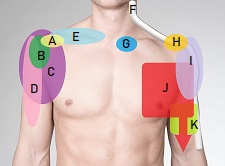- Home
- Shoulder Exercises
- Golfers Elbow Exs
Golfers Elbow Exercises
Written By: Chloe Wilson BSc (Hons) Physiotherapy
Reviewed By: SPE Medical Review Board
Golfers elbow exercises aim to reduce inner elbow pain caused by medial epicondylitis.
Medial epicondylitis is a type of tendonitis caused by overuse from repetitive gripping and forearm movement.
These are common movements in certain sports e.g. golf, tennis or baseball, but are also common in tradespeople e.g. carpenters and plumbers.
There is often some muscle imbalance associated with medial epicondylitis with a combination of weakness, tightness and fatigue. Golfers elbow exercises aim to increase muscle strength, flexibility and endurance and are a vital part of rehab.
Tendonitis typically gets worse over time, so the earlier you start golfers elbow exercises and treatment, the quicker it will heal. It typically takes 3-6 months for medial epicondylitis pain to settle with the correct treatment but in chronic cases, can take up to one year.
Here we will start with a quick introduction to medial epicondylitis and then focus on the best golfers elbow exercises, which ones to do when and how to progress them. If you want to know more about the causes, symptoms, diagnosis and other treatment options, visit the golfers elbow overview.
What Is Golfers Elbow?
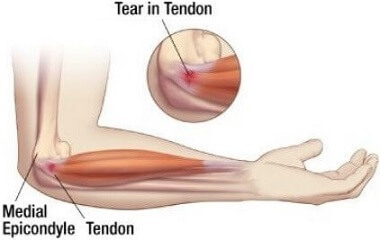
Golfers elbow is an overuse injury that causes inflammation and degeneration of the forearm flexor tendons, where they attach to the inner elbow at the common flexor tendon.
This results in inner elbow pain that may radiate down to the wrist and weakness.
Symptoms of medial epicondylitis get progressively worse if left untreated and tend to be worse with activity rather than rest.
Doing activities such as golf, racket sports, throwing sports, weight-lifting and manual labour for more than an hour at a time on consecutive days increases your risk of developing medial epicondylitis.
Golfers Elbow Treatment
There are lots of different treatment options for medial epicondylitis including:
- Rest: from aggravating activities as much as possible
- Regular Ice
- Medication
- Activity Modification
- Physical Therapy: rehab exercises, electrotherapy, acupuncture
- Steroid Injections
Most cases of golfers elbow will settle down with these treatments and surgery is only indicated in around 3% of cases.
The earlier you start treatment for golfers elbow, the quicker recovery is likely to be as there is less inflammation and micro-tearing of the common flexor tendon. And avoiding aggravating activities as much as possible is key, otherwise it’s like picking at a scab – as soon as it starts to heal it gets damaged again.
Find out more in the Golfers Elbow Treatment section.
Golfers Elbow Exercises
The aim of golfers elbow exercises is to improve the strength, endurance and flexibility of the forearm muscles to reduce the strain through the tendon. This involves a combination of:
- Stretching Exercises: to stretch the wrist flexors and reduce the tension through the common flexor tendon
- Strengthening Exercises: focusing on isometric and eccentric golfers elbow exercises
- Grip Exercises: to target gripping and twisting actions
After these exercises, you will find lots of advice on how to get the best results from your golfers elbows exercises e.g. what to do if it hurts, how to progress and how to work at the right level for you.
A. Golfers Elbow Stretches
Golfers elbow stretches work on stretching out the forearm flexor muscles to reduce the strain through the common flexor tendon. Maximum stretch for each of these is achieved when the elbow and fingers are both straight rather than bent.
You should aim to do one or two of these golfers elbow stretches 2-3 times a day.
1. Wrist Flexor Stretch
This is a simple, yet effective golfers elbow stretch that can be done anywhere.
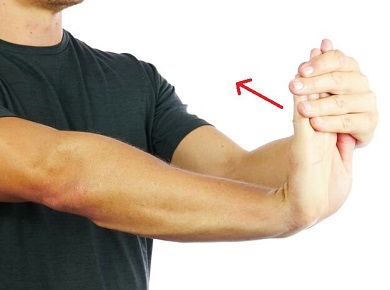
- Sitting or standing, extend the affected arm out so that the elbow is straight, palm facing the floor
- Grasp your fingers of your affected hand and gently bend the wrist up as shown
- Hold for 15-30 seconds and repeat 3 times
Top Tips: 1. If the stretch feels too strong initially, bend the wrist back from the palm so that the fingers can bend slightly
2. To increase the stretch, pull the fingers back further
3. If you notice any tingling or pins and needles across your wrist, you’ve pushed things a little too far, so back off slightly
2. Supinated Golfers Elbow Stretch
This golfers elbow stretch is very similar to the previous one but targets slightly different muscles as the forearm is twisted round – pick whichever one feels best for you.
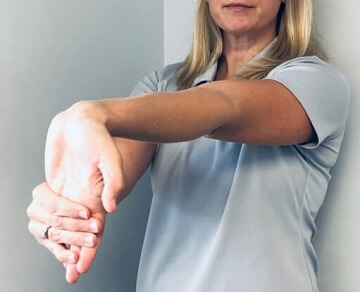
- Sit or stand and straighten your affected arm out at shoulder level in front of you, palm facing the ceiling
- Use you other hand to gently pull the palm and fingers down and back as shown until you feel a stretch
- Hold for 15-30 seconds and repeat 3 times
Top Tip: having the fingers straight will increase the strength of the stretch so vary as needed.
3. Table Extension Stretch
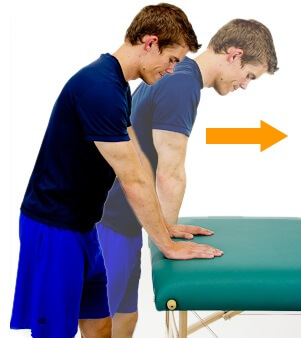
Some people prefer this medial epicondylitis stretch as the hand is in a more fixed position and it stretches both arms at the same time.
- Place both hands on a table, palms down, as shown
- Keeping your elbows straight, slowly lean forwards until you feel a stretch
- Hold for 15-30 seconds and repeat 3-5 times
B. Strengthening Exercises
Strengthening exercises for golfers elbow fall into two stages:
- Isometric Exercises: Static contraction of the muscle without it changing length
- Eccentric Exercises: Actively work the muscles as they lengthen
With any injury, the best place to start is with isometric exercises as they are a great way to start strengthening the muscles without them having to control any movement, or move through a tight range.
With tendon injuries, eccentric exercises have been shown to be more effective than concentric exercises (where you actively work the muscle as it contracts and shortens).
With both isometric and eccentric golfers elbow exercises, it is really important to progress slowly so as not to aggravate things, so follow the guides below. Don’t be tempted to jump onto the next stage too quickly, even if they feel too easy.
And people progress at different rates so don’t worry if it takes a bit longer to progress through some of the stages – be guided by your symptoms.
1. Isometric Golfers Elbow Exercise
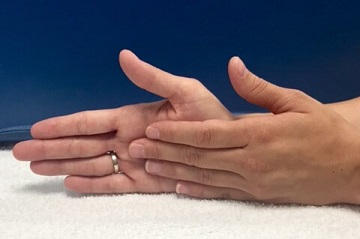
- Place the affected forearm on a table or chair arm, resting on your little finger as shown and place your other hand over your palm
- Push the affected hand down as if you were trying to bend your wrist, but resist the movement with your other hand
- You should feel the muscles in your forearm working but there shouldn’t be any movement at the wrist
- Aim to do this exercise 3-4 times per day
Week 1: Hold for 10 seconds and repeat 5 times
Week 2: Hold for 20 seconds and repeat 5 times
Week 3: Hold for 30 seconds and repeat 5 times
Week 4: Hold for 45 seconds and repeat 3 times
2. Eccentric Golfers Elbow Exercise
The key with these golfers elbow exercises is to make sure the muscle is only working eccentrically (as it lengthens). You want to avoid concentric exercises as much as possible with tendon injuries as they are less effective and can actually overload the tendon. It may seem a bit of a faff to keep lifting the affected hand up with the other hand, but it really is worth it to isolate the movement to eccentric work.
Stage 1
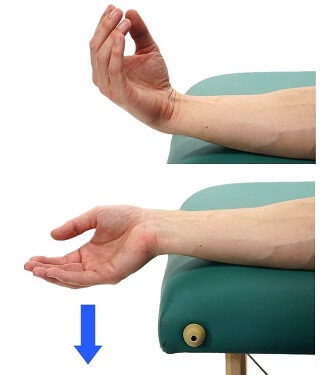
- Rest your affected forearm on a table or chair arm, palm up, and let you hand hang over the edge
- Use you other hand to lift up the affected hand so the wrist is bent up – you want the unaffected arm doing all the work here
- Release the grip of the affected hand and let it slowly lower down so the wrist bends back
- Make sure the movement is slow and controlled, don’t just let the hand flop back
- Then grasp the affected hand again and lift it back up
- Repeat 15 times, 3 times a day for 1-2 weeks
- Gradually increase to 25 repetitions over the next 2-4 weeks. Remember to take your time!
Stage 2
Make sure you can do 25 reps of stage 1 without any pain before progressing to stage 2. Start in the same way as stage 1 but hold a small weight in the affected hand e.g. a light hand-weight or a can
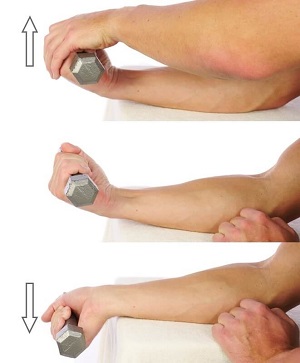
- Lift the hand holding the can up with your other hand so the wrist is bent up – make sure the unaffected arm does all the work
- Let go of the affected hand and slowly let the wrist move back and down, lowering the weight in a slow, controlled fashion
- Use the opposite hand to lift the affected hand back up
- Repeat 10 times, 3 times a day for 1-2 weeks
- Gradually increase to 25 repetitions over the next 2-4 weeks
Stage 3
Once you can do 25 reps without any pain, you can switch to using a slightly heavier weight with this golfers elbow exercise.
You should reduce the number of repetitions initially back to 10 and gradually build back up to 25 reps over a few weeks. Be guided by pain.
Top Tip: Don’t try and use really heavy weights here, a good guide is the weight should be no more than about a third of the maximum weight you could hold. Eccentric work is all about control, not about maximum contractions.
C. Hand Grip Exercises
Once your medial epicondylitis pain is starting to settle and you are progressing well with your eccentric wrist exercises, you can add in some gripping and twisting exercises to help with functional activities. Again, start slowly and take your time increasing the hold and the number of reps so you don’t overload the tendon too quickly.
1. Towel Clench
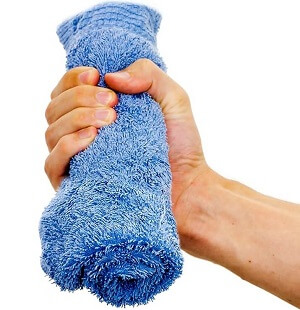
- Roll up a towel into a cylinder shape and hold it in your affected hand
- Grip the towel and gently squeeze it, gradually using more force
- Hold for 10 seconds and repeat 5-15 times, 3 times a day, for the first 2 weeks
Week 3-4: hold 15-20 secs, 5-20 reps
Week 5-6: hold 25-30 secs, 5-20 reps
Week 7+: hold 35-45 secs, 5-20 reps
Top Tips: If this golfers elbow exercise causes any discomfort, use a slightly thicker towel so you have a wider grip – the narrower the grip, the more strain through the common flexor tendon. Over time, you may want to reduce the thickness of the towel to make it more functional, and if you are going to be using sports equipment or work tools, you might like to switch to using your racket or tools instead of the towel
2. Pronation/Supination
- Holding a small weight or a can, rest your forearm on your knee or on a table, palm facing the ceiling
- Place your other hand on your forearm, just below the elbow as an anchor
- Slowly twist your wrist, bringing the weight inwards as you turn your palm to face downwards
- Then twist the wrist back, taking the weight outwards to bring the palm to face up again
- Repeat 15-30 times each way, twice a day
Progression: as long as there is no pain with this exercise, you can increase the weight you use
How To Get The Best Results
It is really important to progress slowly with golfers elbow exercises as the last thing you want to do is overwork the muscles and cause more strain on the tendon.
There may be a slight increase in pain while you are doing these exercises, especially at the start, but that should quickly settle down. Your symptoms should return to your pre-exercise baseline within 30 minutes of exercising with little noticeable effect the next day.
If you find that doing these golfers elbow exercises increases your pain significantly either at the time, or later that day or the next, try:
- Reducing the number of repetitions
- Reducing the speed of the exercises
- Reducing the amount of movement during an exercise i.e. don’t push it as far
- Increasing the rest time between exercises or repetitions
- Timing the exercises around your medications: do the exercises 30-60 minutes after taking any pain relief so they’ve had a chance to kick in
It is important to be aware that golfers elbow exercises are not a quick fix for medial epicondylitis. It can often take 2-3 months to notice a significant reduction in your symptoms. But you should find that they get easier to do and that you can gradually progress through the different stages of exercises
Things To Avoid
With medial epicondylitis, it is really important to avoid strain through the common flexor tendon to allow it time to heal so try to avoid:
- Movements That Aggravate Your Symptoms: should be avoided as much as possible
- Repetitive Pulling or Lifting: especially anything heavy or with your palm facing upwards
- Repetitive Gripping: e.g. work tools or rackets
What Else Can Help?
Golfers elbow exercises help to increase the strength, flexibility and endurance of the wrist and hand flexors which in turn reduces the strain through the common flexor tendon.
Not all cases of inner elbow pain are due to golfers elbow. Medial forearm pain that extends down to the wrist, particularly if it associated with tingling or numbness is more likely to be due to arm nerve pain and will be treated differently.
Exercises are an important part of golfers elbow rehab but there are other treatments that can be done alongside the exercises to get the best results e.g. injections, activity modification and acupuncture. You can find out more about the different treatment options in the Golfers Elbow Overview.
Page Last Updated: 01/19/2023
Next Review Due: 01/19/2025

